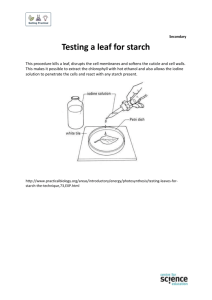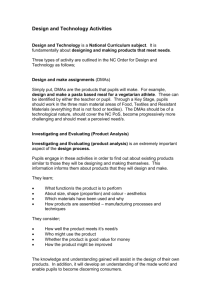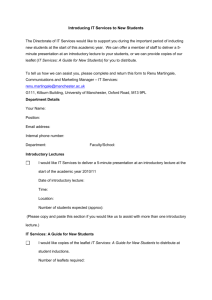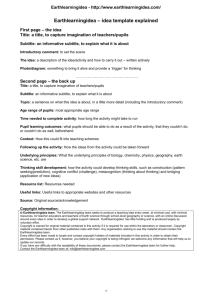Word Document
advertisement
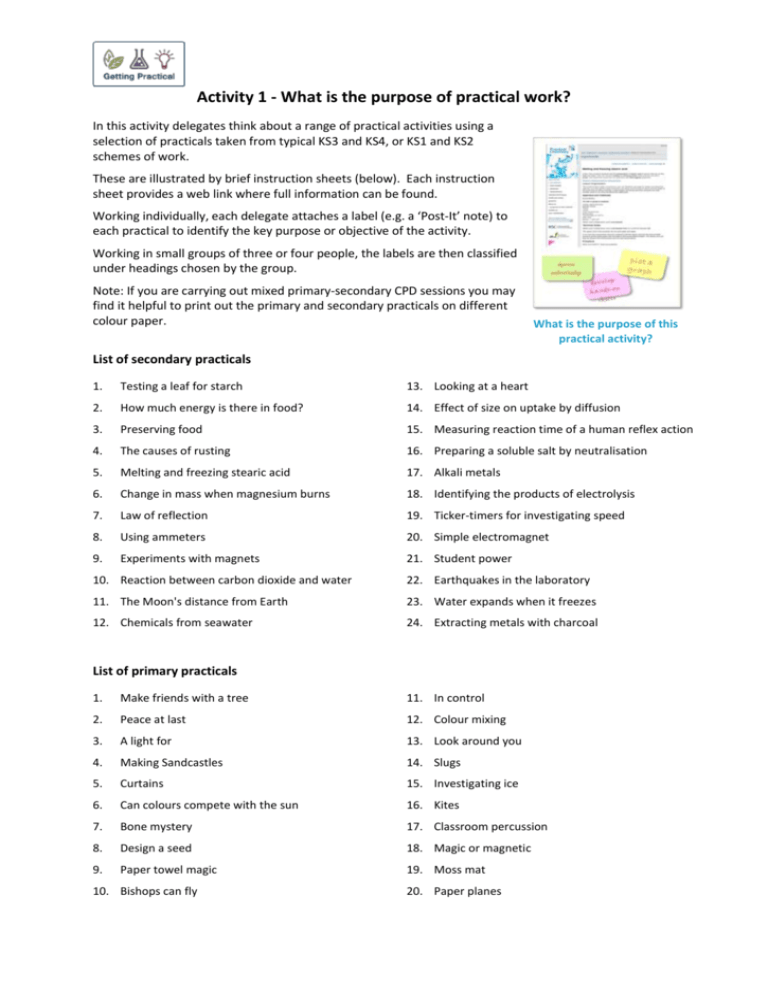
Activity 1 - What is the purpose of practical work? In this activity delegates think about a range of practical activities using a selection of practicals taken from typical KS3 and KS4, or KS1 and KS2 schemes of work. These are illustrated by brief instruction sheets (below). Each instruction sheet provides a web link where full information can be found. Working individually, each delegate attaches a label (e.g. a ‘Post-It’ note) to each practical to identify the key purpose or objective of the activity. Working in small groups of three or four people, the labels are then classified under headings chosen by the group. Note: If you are carrying out mixed primary-secondary CPD sessions you may find it helpful to print out the primary and secondary practicals on different colour paper. What is the purpose of this practical activity? List of secondary practicals 1. Testing a leaf for starch 13. Looking at a heart 2. How much energy is there in food? 14. Effect of size on uptake by diffusion 3. Preserving food 15. Measuring reaction time of a human reflex action 4. The causes of rusting 16. Preparing a soluble salt by neutralisation 5. Melting and freezing stearic acid 17. Alkali metals 6. Change in mass when magnesium burns 18. Identifying the products of electrolysis 7. Law of reflection 19. Ticker-timers for investigating speed 8. Using ammeters 20. Simple electromagnet 9. Experiments with magnets 21. Student power 10. Reaction between carbon dioxide and water 22. Earthquakes in the laboratory 11. The Moon's distance from Earth 23. Water expands when it freezes 12. Chemicals from seawater 24. Extracting metals with charcoal List of primary practicals 1. Make friends with a tree 11. In control 2. Peace at last 12. Colour mixing 3. A light for 13. Look around you 4. Making Sandcastles 14. Slugs 5. Curtains 15. Investigating ice 6. Can colours compete with the sun 16. Kites 7. Bone mystery 17. Classroom percussion 8. Design a seed 18. Magic or magnetic 9. Paper towel magic 19. Moss mat 10. Bishops can fly 20. Paper planes Testing a leaf for starch This procedure kills a leaf, disrupts the cell membranes and softens the cuticle and cell walls. This makes it possible to extract the chlorophyll with hot ethanol and also allows the iodine solution to penetrate the cells and react with any starch present. http://www.practicalbiology.org/areas/introductory/energy/photosynthesis/testing-leaves-forstarch-the-technique,73,EXP.html How much energy is there in food? Take samples of a range of foodstuffs and set them alight in turn. Burn food samples under a boiling tube containing a measured amount of water. Measure the temperature increase in the water. Calculate the amount of energy needed to cause that temperature increase. This gives an estimate of the amount of energy stored in the food. The apparatus is very simple and the protocol gives only a very approximate estimate for each foodstuff, so there is scope for students to suggest improvements in an evaluation. http://www.practicalbiology.org/areas/introductory/energy/energy-in-food/how-much-energy-is-there-infood,42,EXP.html Preserving food Pupils investigate the effect of different preservatives on frozen peas in order to establish that decay is caused by the action of microbes, and therefore preservatives work by reducing microbe activity. http://www.practicalbiology.org/areas/introductory/health-and-disease/preserving-food/preservingfood,96,EXP.html Law of reflection Class experiment showing that angle of incidence is equal to angle of reflection. http://www.practicalphysics.org/go/Experiment_644.html?topic_id=2&collection_id=101 Using ammeters In this experiment pupils measure the current at various places in series and parallel circuits. This provides an opportunity to introduce the ampere unit. http://www.practicalphysics.org/go/Experiment_271.html?topic_id=8&collection_id=32 Experiments with magnets Magnets provide an introduction to attraction and repulsion, and to action at a distance. Pupils investigate pairs of magnets, plotting compasses and iron filings. http://www.practicalphysics.org/go/Experiment_189.html?topic_id=3&collection_id=26 The Moon’s distance from Earth An estimate of the ratio of the Moon’s distance from the Earth compared to its diameter. To complete this experiment, hold a small coin just beyond arm's length and adjust its distance from the eye until the disc of the coin just obscures the disc of the moon. A partner can then measure the distance from the eye to the coin. http://www.practicalphysics.org/go/Experiment_936.html?topic_id=43&collection_id=115 Investigating the effect of caffeine on the reaction time of a human reflex action Pupils use a familiar protocol (dropping and catching a metre ruler) to investigate the effect of drinking caffeinated drinks on their reaction times. http://www.practicalbiology.org/areas/intermediate/control-and-communication/reflex-actions/measuringreaction-time-of-a-human-reflex-action,88,EXP.html Ticker-timers for investigating speed Making ticker-timer charts can develop an understanding of speed-time graphs. One person should operate the ticker-timer switch while another walks away, pulling tape through the ticker-timer. The walker should speed up and then slow down and stop, while the tape is running through the timer. http://www.practicalphysics.org/go/Experiment_266.html?topic_id=3&collection_id=31 Simple electromagnet An introductory experiment using a wire wrapped round an iron nail, which shows that electromagnets can conveniently be switched on and off. http://www.practicalphysics.org/go/Experiment_323.html?topic_id=7&collection_id=43 Student power Students measure their personal power by running up a flight of stairs. http://www.practicalphysics.org/go/Experiment_511.html?topic_id=39&collection_id=74 Water expands when it freezes In this demonstration a bottle is filled with water and allowed to freeze. The water expands as it freezes which breaks the bottle. This is useful when teaching about the weathering of rocks and freeze-thaw. http://www.practicalchemistry.org/experiments/introductory/the-earth/water-expands-when-itfreezes,190,EX.html
